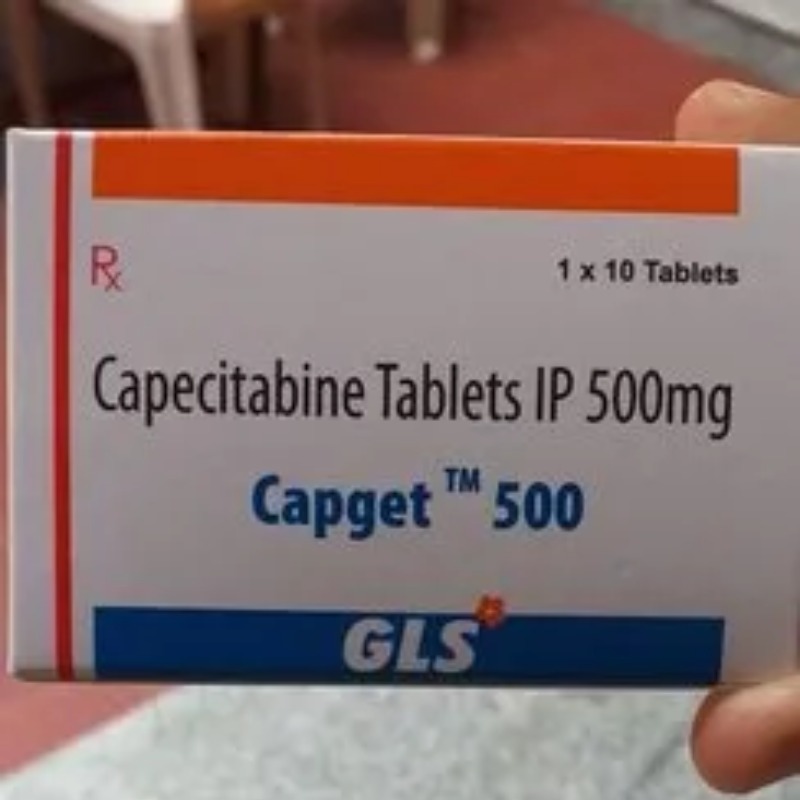DESCRIPTION
Capecitabine
MECHANISM OF ACTION
• Fluoropyrimidine carbamate prodrug form of 5-FU. Capecitabine itself is inactive.
• Activation to cytotoxic forms is a complex process that involves three successive enzymatic steps. Metabolized in liver
to 5’-deoxy-5- fluorocytidine (5’-DFCR) by the carboxylesterase enzyme and then to
• 5’-DFUR by cytidine deaminase (found in liver and in tumor tissues). Subsequently converted to 5-FU by
the enzyme thymidine phosphorylase, which is expressed in higher levels in tumor versus normal tissue.
• Inhibition of the target enzyme thymidylate synthase (TS) by the 5-FU
• metabolite FdUMP.
• Incorporation of 5-FU metabolite FUTP into RNA, resulting in alterations in RNA processing and/or mRNA
translation.
• Incorporation of 5-FU metabolite FdUTP into DNA, resulting in inhibition of DNA synthesis and function.
•Inhibition of TS leads to accumulation of dUMP and subsequent misincorporation of dUTP into DNA, resulting in inhibition
of DNA synthesis and function.
ABSORPTION
Capecitabine is readily absorbed by the GI tract. Peak plasma levels are reached in 1.5 hours, while peak 5-FU levels are achieved
at 2 hours after oral administration. The rate and extent of absorption are reduced by food.
Plasma protein binding of capecitabine and its metabolites is less than 60%.
Primarily bound to albumin (35%).
INDICATIONS
• Metastatic breast cancer—FDA-approved when used in combination with docetaxel for the treatment of patients with metastatic breast
cancer after failure of prior anthracycline-containing chemotherapy.
• Metastatic breast cancer—FDA-approved as monotherapy in patients refractory to both paclitaxel- and anthracycline-based
chemotherapy or when anthracycline therapy is contraindicated.
• Metastatic colorectal cancer—FDA-approved as first-line therapy when fluoropyrimidine therapy alone is preferred.
• Stage III colon cancer—FDA-approved as adjuvant therapy when fluoropyrimidine therapy alone is preferred.
• Clinical activity in gastric cancer, gastroesophageal cancer, and other GI cancers.
DOSAGE RANGE
• Recommended dose is 1,250 mg/m2 PO bid (morning and evening) for 2 weeks with 1 week rest. For combination therapy (capecitabine in
• combination with docetaxel) with docetaxel being dosed at 75 mg/m2 day 1 of a 21-day cycle.
• May decrease dose of capecitabine to 850–1,000 mg/m2 bid on days 1–14 to reduce risk of toxicity without compromising efficacy (see section Special Considerations [8]).
• An alternative dosing schedule for capecitabine monotherapy is 1,250– 1,500 mg/m2 PO bid for 1 week on and 1 week off.
This schedule appears to be well tolerated, with no compromise in clinical efficacy.
• Capecitabine should be used at lower doses (850–1,000 mg/m2 bid on days 1–14) when used in combination
with other cytotoxic agents, such as oxaliplatin.
DRUG INTERACTION 1
Capecitabine-warfarin interaction—Patients receiving concomitant capecitabine and oral coumarin-derivative anticoagulant therapy should have their coagulation parameters (PT and INR) monitored frequently in order to adjust the anticoagulant dose accordingly. A clinically important capecitabine–warfarin drug interaction has been documented. Altered coagulation parameters and/ or bleeding, including death, have been reported in patients taking capecitabine concomitantly with coumarin-derivative anticoagulants such as warfarin. Post-marketing reports have shown clinically significant increases in PT and INR in patients who were stabilized on anticoagulants at the time capecitabine was introduced. These events occurred within several days and up to several months after initiating capecitabine therapy and, in a few cases, within 1 month after stopping capecitabine. These events occurred in patients with and without liver metastases. Age > 60 and a diagnosis of cancer independently predispose patients to an increased risk of coagulopathy.
DRUG INTERACTION 2
Aluminum hydroxide, magnesium hydroxide—Concomitant use of aluminum hydroxide– or magnesium hydroxide–containing antacids
may increase the bioavailability of capecitabine by 16%–35%.
DRUG INTERACTION 3
Phenytoin—Capecitabine may increase phenytoin blood levels and subsequent phenytoin toxicity. Dose adjustment of phenytoin may be necessary.
DRUG INTERACTION 4
Leucovorin—Leucovorin enhances the antitumor activity and toxicity of capecitabine.
SPECIAL CONSIDERATIONS
• Capecitabine should be taken with a glass of water within 30 minutes after a meal.
• Contraindicated in patients with known hypersensitivity to 5-FU.
• Contraindicated in patients with known dihydropyrimidine dehydrogenase (DPD) deficiency.
• No dose adjustments are necessary in patients with mild or moderate liver dysfunction. However, patients should be closely monitored.
• In the setting of moderate renal dysfunction (baseline CrCl, 30–50 mL/min), a 25% dose reduction is recommended. Patients should be closely monitored, as they may be at greater risk for increased toxicity. Contraindicated in patients with severe renal impairment (CrCl < 30 mL/min).
• Patients should be monitored for diarrhea and its associated sequelae, including dehydration, fluid imbalance, and infection. Elderly patients (> 80 years of age) are especially vulnerable to the GI toxicity of capecitabine. Moderate-to-severe diarrhea (> grade 2) is an indication to interrupt therapy immediately. Subsequent doses should be reduced accordingly.
• Drug therapy should be stopped immediately in the presence of grades 2 to 4 hyperbilirubinemia until complete resolution or a decrease in intensity to grade 1.
• Drug therapy should be stopped immediately in the presence of grade 2 or higher adverse events until complete resolution or a decrease in intensity to grade 1. Treatment should continue at 75% of the initial starting dose for grade 2 or 3 toxicity. For grade 4 toxicities, if the physician chooses to continue treatment, treatment should continue at 50% of the initial starting dose.
• Patients who experience unexpected, severe grade 3 or 4 myelosuppression, GI toxicity, and/or neurologic toxicity upon initiation of therapy may have an underlying deficiency in dihydropyrimidine dehydrogenase. Therapy must be discontinued immediately, and further testing to identify the presence of this pharmacogenetic syndrome should be considered.
• Vitamin B6 (pyridoxine, 50 mg PO bid) may be used to prevent and/or reduce the incidence and severity of hand-foot syndrome. Dose may be increased to
100 mg PO bid if symptoms do not resolve within 3–4 days.
• Celecoxib at a dose of 200 mg PO bid may be effective in preventing and/ or reducing the incidence and severity of hand-foot syndrome. A low-dose nicotine patch has also been found to be effective in this setting.
• In patients with the hand-foot syndrome, the affected skin should be well hydrated using a bland and mild moisturizer. Instruct patients to soak affected hands and feet in cool to tepid water for 10 minutes, then apply petroleum jelly onto the wet skin. The use of
lanolin-containing salves or ointments such as Bag Balm emollient may help.
• Diltiazem can prevent capecitabine-induced coronary vasospasm and chest pain and may allow patients to continue to receive capecitabine.
• Pregnancy category D. Breastfeeding should be avoided.
TOXICITY 1.
Diarrhea is dose-limiting, observed in up to 55% of patients. Similar to GI toxicity observed with continuous
infusion 5-FU. Mucositis, loss of appetite, and dehydration also noted.
TOXICITY 2
Hand-foot syndrome (palmar-plantar erythrodysesthesia). Severe hand-foot syndrome is seen in 15%–20% of patients. Characterized
by tingling, numbness, pain, erythema, dryness, rash, swelling, increased pigmentation, and/or pruritus of the hands and feet.
Similar to dermatologic toxicity observed with continuous infusion 5-FU.
TOXICITY 3
Nausea and vomiting occur in up to 50% of patients.
TOXICITY 4
Elevations in serum bilirubin (20%–40%), alkaline phosphatase, and hepatic transaminases (SGOT, SGPT). Usually transient and
clinically asymptomatic.
TOXICITY 5
Myelosuppression is observed less frequently than with IV 5-FU. Leukopenia more common than thrombocytopenia.
TOXICITY 6
Neurologic toxicity manifested by confusion, cerebellar ataxia, and rarely encephalopathy.
TOXICITY 7
Cardiac symptoms of chest pain, ECG changes, and serum enzyme elevation. Rare event but increased risk in patients with
prior history of ischemic heart disease.
SPECIFICATION


Login To Comment